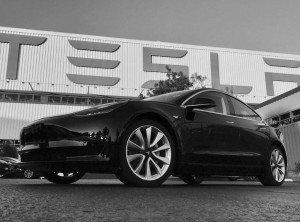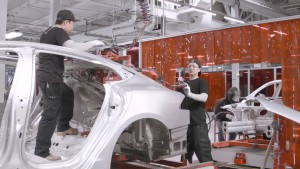Despite promises by CEO Elon Musk, Tesla has yet to dig its way out of the “production hell” it has faced since the launch of its Model 3 battery sedan last July.
The Silicon Valley carmaker said it delivered just 1,550 of the “affordable,” long-range electric vehicles during the fourth quarter, well below what industry analysts had been anticipating. Some had forecast the numbers would come closer to 9,000 for the October-December quarter, with even pessimists forecasting something closer to 4,000.
The shortfall means that many of the roughly 400,000 customers who have plunked down $1,000 deposits for a Model 3 could be waiting well into 2019 before taking delivery, observers warned. It also raises the specter that Tesla might have to seek more capital to offset continuing losses. The company had said it would finally get into the black as production reached the longer-term target of 10,000 vehicles a week.
Tesla officially launched production of the Model 3 in July, the first time it had ever delivered a new vehicle on schedule. But little has gone right since then. Musk last summer warned his company would face “production hell” in ramping up the line rate at its Fremont, California assembly plant. And in that sense, he hasn’t disappointed.
During the third quarter of 2017, Tesla produced a mere 220 Model 3s. The company on Wednesday said it has made “major progress” towards breaking “production bottlenecks.” But it didn’t come close to its original forecast, which would have seen the Fremont plant rolling out 5,000 of the electric sedans a week. That target, previously postponed until the end of Q1 2018 is now a stretch goal for the second quarter.
(Musk gives twitter users a peek behind the curtain. Click Here for the story.)
It’s not clear when Tesla will meet the 10,000 weekly target it had originally forecast for the end of 2018 – a rate that would have boosted Fremont’s production to an annualized 500,000. In fact, Tesla officials late last year said they have not yet even approved the money needed to boost production rates past 5,000 a week.
Unless the carmaker can fix its remaining production problems in the coming months, analysts like CFRA’s Efraim Levy warn the automaker will fall short of cash and need to seek out new capital.
For its part, Tesla defended its go-slow strategy, insisting that it will “focus on quality and efficiency rather than simply pushing for the highest possible volume in the shortest period of time.” There have been numerous reports indicating that a large number of the Model 3 sedans rolling out of Fremont must be set aside for rework before they can be delivered to customers. There was a significant buzz at the Los Angeles Auto Show in November when visitors began noticing extensive fit-and-finish problems with the Model 3 on display there.
(Click Here to see more about the first Model 3 delivered to customers.)
Despite the painful problems with the Model 3 launch, Tesla did note that things went well for its two other current models during the final quarter of 2017.
“In total, we exceeded our previously announced guidance by delivering 101,312 Model S and X vehicles in 2017. This was a 33% increase,” the automaker said.
Despite the ongoing problems with the Model 3, investors have largely remained bullish about Tesla. Though its shares dipped 1.02% at the end of Wednesday trading it still managed to close at $317.25 a share. That was down from a 52-week high of $389.61 but well ahead of the year-long low of $214.31.
(Elon Musk is “dying” to build a pickup. Find out his plan. Click Here.)
Looking forward, “In the 12-month investable time frame our rating contemplates, we see Tesla as a great company led by a true visionary, but must acknowledge the asymmetric risk/reward profile for the stock at the market’s current valuation,” Cowen analyst Jeff Osborne wrote investors. “Simply, we see a lot more that can go wrong than can go right as the company transitions into Mr. Musk’s greater vision as laid out in his Master Plan, Part Deux.”



Musk should have robbed a Ford/GM plant manager and launch team and stayed out of their way. When’s the last time a Ford or GM launch was more than a week behind schedule? For the aluminum F-Series, Ford pretty much emptied the factory and started with all new equipment.
There’ve been a few pushed back because of production issues but nothing like this.
Paul E.
Tesla DID have people they hired from other OEMs, but I believe they’ve all pretty much left.
Agree with both. From the overly-aggressive time-to-launch schedules (like more due to cash reserves / being cash-strapped than actual belief in making the date) to making promises / keeping the “flash” going, Tesla’s launches have all been disasters. Musk is cutting his own throat.
To start, put out a realistic date / time frame
Next as Jim stated, get real plant manager(s) / launch teams and SOOTW (Stay Out Of Their Way)
Understand quality is more perception than anything, especially when there’s nothing to deliver. The longer it takes to deliver the more the customer will scrutinize the product. Small gaps they may have been willing to overlook or live with will now become HUGE fitment issues.
People aren’t going to wait forever to get your act together